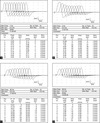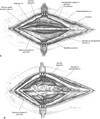Neuro Flashcards
(241 cards)
What are the 3 types of ataxia?
Vestibular = inner ear, CNVIII periheral (often CN 7 and horners), vestibular nuclei rostral medullar oblongata - central (often CP def, islat CN5&7 def)
proprioceptive (lesion at or caudal to midbrain, usually spinal)
cerebellar = hypermetria
What is decerbrate rigidity?
opisthotonus + rigidity extension 4 limbs =midbrain/rostarl cerebellar lesion
What is decebellate ridgitiy?
opisthotonus + rigidity extension 4 limbs with hip flexed = cerebellum
What is pleurothotonus?
head and neck deviated to one side - mid rostral brainstem, cerebral lesions
What spinal tracts are associated with the general proprioceptive pathway and UMN pathway?
General: spinocerebellar tracts (unconcisous proprioception), fasciculatus gracillus and cuneatus (CP HL and FL)
UMN pathway: reticulospinal and rubrospinal
What is the modified Frankel score?
What spinal segments are associated with the femoral n?
L4-L6
How do you grade the patellar reflex?
0 = absent
1= hypo
2= normal
3= hyper
4= clonic
What nerves to the biceps and triceps reflex test?
Biceps = musculocutaneous (C6-C8)
Triceps = radial = (C7-T2)
What nerves are responisble for withdrawal in the forelimb and hind limb?
Forelimb = dorsal thoracic, axillary, musculocutaneous, median, ulnar and radial (C6-T2)
HL = sciatic (L6-S1)
Where is the cutaneious trunci reflex relayed to?
C8-T1
What does the cross extensor test indicate?
UMN lesion on the opposite side tested
Opposite side extends during withdrawl
What are the cranial n?
1= oflactory 2 = optic, 3 = occulomotor 4= trochlear 5=trigeminal 6= abducens 7= fascial 8= auditory/vestibulocochlear 9= glossophyngeal 10= vagus 11= spinal/accesory 12= hypoglossal
on old olympus towering top a finn and German veiwed some hops
Some say marry money but my brother says big busniess make money
What CN do menace, pupillary light and palpebral test?
menace = CN 2 and 7
pupillary reflex = CN 2 and 3 (also palpebral fissure)
palpebral = CN 5 and 7

What is the pathway of the menace reflex?
CN2, optic tract, lateral genicular nucleus (thalmus/diencephalon), occiptal lobe cerebrum, cerebeullum and facial.

When can evidence of Horner’s syndrome be seen (aka what are possible areas of damage to the sympathetic tracts)?
T1-T3
C1-C5
bracial plexsus
otitis media/interna - sympathetic fibers in petrous portion of the temporal bone
What are signs of CN 3 dysfunction?
Ventrolateral strabismus; ptosis; dilated pupils; diminished to absent PLRs
Normally: Motor to extraocular muscles; parasympathetic to pupil
Test with physiologic nystagmus and PLR
What are signs of dysfucntion of CN 4?
Dorsomedial strabismus (cat); lateral deviation of retinal vein (dog)
Normal: Motor to dorsal oblique muscle
Test: Resting eyeball position (cat); fundic examination (dog)
What are signs of CN 5 dysfunction?
Masticatory muscle atrophy; dropped jaw if bilateral; decreased or absent facial/nasal sensation
Normal: Motor to muscles of mastication (mandibular); sensory to face (ophthalmic, maxillary, mandibular)
Test: Jaw tone; muscle bulk; sensation to face, cornea, and nasal mucosa
What are signs of CN 6 dysfunction?
Medial strabismus
Normal = Motor to lateral rectus and retractor bulbi
Test = Physiologic nystagmus; resting eyeball position
What is CN 7 responisble for besides facial movement?
Motor to muscles of facial expression; parasympathetic to lacrimal glands; sensory (taste) to rostral tongue
Test: Menace response; palpebral reflex; lip retraction; ear movement; Schirmer tear test
What does CN 10 do?
Sensory and motor to pharynx, larynx, and viscera
Test with Gag reflex or oculocardiac reflex
Diminished gag reflex; dysphagia; laryngeal paralysis; megaesophagus
CN 9 is also associated with gag reflex and dysphagia
What does the accessory n do?
Motor to trapezius
Test: Evaluation of muscle mass
Dysfunctional = Atrophy of trapezius
Describe the pathway for vestibular nystagmus?
CN8 → brainstem → vestibular nuclei → medial longitudinal fasciculus → abducens and oculomotor

























































































